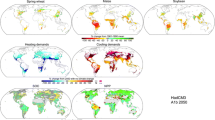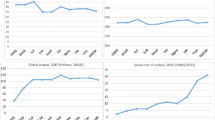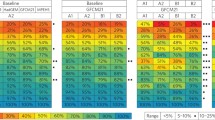Abstract
Many models have been developed to explore the likely consequences of climate change. These models tend to focus on single physical or socio-economic sectors and their processes, and neglect the many feedbacks that occur between the different components of the real world. To overcome this problem, models are increasingly being combined in integrated assessment platforms (IAPs), of which the CLIMSAVE IAP is an example, modelling cross-sectoral impacts, adaptation and vulnerability to climate change in Europe by combining 10 different meta-models that focus on specific sectors. Where models are combined in this way, however, attention must be given to the potential errors and uncertainties that integration might introduce. We present a quantitative uncertainty analysis of selected outputs of the CLIMSAVE IAP based on creating and sampling from probability density functions (PDFs) of each of the IAP’s input variables to take account of model and scenario uncertainty. We find limited uncertainties in aggregate outputs of the IAP, which allow specific impacts to be predicted with definable levels of confidence. However, we also find substantial overlap between different socio-economic scenarios at the European scale, suggesting that changes to socio-economic conditions cannot reliably overcome climate-related uncertainty. Nevertheless, there is evidence that particular adaptation actions may significantly alter the impacts of climate change, especially at local or national scales.



Similar content being viewed by others
References
AAHS (Ausvet Animal Health Services). (2013). Estimation of alpha and beta Parameters for Prior Beta distributions. Retrieved from http://epitools.ausvet.com.au/content.php?page=BetaParams1
Ackerman F, DeCanio SJ, Howarth RB, Sheeran K (2009) Limitations of integrated assessment models of climate change. Clim Chang 95(3-4):297–315. doi:10.1007/s10584-009-9570-x
Adger WN, Dessai S, Goulden M et al (2008) Are there social limits to adaptation to climate change? Clim Chang 93(3–4):335–354. doi:10.1007/s10584-008-9520-z
Anderson K, Bows A (2011) Beyond “dangerous” climate change: emission scenarios for a new world. Philosophical transactions. Ser A Math Phys Eng Sci 369(10):20–44. doi:10.1098/rsta.2010.0290, 1934
Arnell NW, Livermore MJL, Kovats S et al (2004) Climate and socio-economic scenarios for global-scale climate change impacts assessments: characterising the SRES storylines. Glob Environ Chang 14(1):3–20
Audsley, E., Trnka, M., Sabaté, S., Sanchez, A. (2014). Interactively modelling of land profitability to estimate European agricultural and forest land use under future scenarios of climate, socio-economics and adaptation.
Bellard C, Bertelsmeier C, Leadley P, Thuiller W, Courchamp F (2012) Impacts of climate change on the future of biodiversity. Ecol Lett. doi:10.1111/j.1461-0248.2011.01736.x
Dawson, T. P., Jackson, S. T., House, J. I., Prentice, I. C., Mace, G. M. (2011). Beyond predictions: biodiversity conservation in a changing climate. Sci 332(6025):53–8. doi:10.1126/science.1200303
Dubrovsky, M., Trnka, M., Svobodova, E., Dunford, R., Holman, I.P. (2014). Creating a reduced-form ensemble of climate change scenarios for Europe representing known uncertainties
Dunford, R., Harrison, P.A., Rounsevell, M.D.A. (2014). The importance of considering cross-sectoral uncertainty in climate change and adaptation assessments.
Füssel HM (2010) Modeling impacts and adaptation in 27 global IAMs. Wiley Interdiscip Rev Clim Chang 1(2):288–303. doi:10.1002/wcc.40
Gerst MD, Howarth RB, Borsuk ME (2013) The interplay between risk attitudes and low probability, high-cost outcomes in climate policy analysis. Environ Model Softw 41:176–184
Hallegatte S, Hourcade JC, Dumas P (2007) Why economic dynamics matter in assessing climate change damages: Illustration on extreme events. Ecol Econ 62(2):330–340
Harrison PA, Holman IP, Cojocaru G et al (2013) Combining qualitative and quantitative understanding for exploring cross-sectoral climate change impacts, adaptation and vulnerability in Europe. Reg Environ Chang 13(4):761–780. doi:10.1007/s10113-012-0361-y
Harrison, P.A., Holman, I.P., Berry, P.M. (2014(a)). Editorial: Assessing cross-sectoral climate change impacts, adaptation and vulnerability: An Introduction to the CLIMSAVE project.
Harrison, P.A., Dunford, R., Holman, I.P. et al. (2014(b)). Cross-sectoral implications of different climatic and socio-economic scenario futures in Europe.
Heath LS, Smith JE (2000) An assessment of uncertainty in forest carbon budget projections. Environ Sci Pol 3(2–3):73–82
Holman IP, Rounsevell MDA, Shackley S et al (2005) A regional, multi-sectoral and integrated assessment of the impacts of climate and socio-economic change in the Uk. Clim Chang 71(1–2):9–41. doi:10.1007/s10584-005-5927-y
Holman, I., Cojocaru, G., Harrison, P. (2013). Guidance report describing the final version of the CLIMSAVE Integrated Assessment Platform. Retrieved 20 February 2014 from: http://www.climsave.eu/climsave/doc/Report_on_the_Final_IA_Platform.pdf
Ibáñez, I., Diez, J., Miller, L. P. et al. (2013). Integrated Assessment of Biological Invasions. Ecological Applications, in press. doi:10.1890/13-0776.1
IPCC - Intergovernmental Panel on Climate Change. (2013). Climate change 2013: the physical science basis. Retrieved September 11, 2013, from http://www.ipcc.ch/report/ar5/wg1/#.UphvZsRdVBk
Jäger J., Rounsevell, M.D.A., Harrison, P.A. et al. (2014). Regional integrated assessment to inform robust policy responses to climate change.
Jansen MJW (1999) Analysis of variance designs for model output. Comput Phys Commun 56(117):35–43
Kebede, A.S., Audsley, E., Dunford, R. Et al. (2014). The sensitivity of cross-sectoral impacts of climate and socio-economic drivers on key European sectors.
Kok, K., Flörke M., Gramberger, M. et al. (2014). Participatory scenario development: strengthening the link between stories and models.
Lambin EF, Turner BL, Geist HJ et al (2001) The causes of land-use and land-cover change: moving beyond the myths. Glob Environ Chang 11(4):261–269. doi:10.1016/S0959-63 3780(01)00007-3
Lavorel S, Flannigan MD, Lambin EF, Scholes MC (2006) Vulnerability of land systems to fire: interactions among humans, climate, the atmosphere, and ecosystems. Mitig Adapt Strateg Glob Chang 12(1):33–53. doi:10.1007/s11027-006-9046-5
Masson D, Knutti R (2011) Climate model genealogy. Geophys Res Lett 38(8):76. doi:10.1029/2011GL046864
Mendelsohn R, Schlesinger M, Williams L (2000) Comparing impacts across climate models. Integr Assess 1(1):37–48. doi:10.1023/A:1019111327619
Mokrech, M., Kebede, A.S., Nicholls, R.J., Wimmer, F. (2014). Assessing flood impacts due to cross-sectoral effects of climate and socio-economic scenarios and the scope of adaptation
Moss RH, Edmonds JA, Hibbard KA et al (2010) The next generation of scenarios for climate change research and assessment. Nature 463(7282):747–56. doi:10.1038/nature08823
Mote P, Brekke L, Duffy PB, Maurer E (2011) Guidelines for constructing climate scenarios. EOS Trans Am Geophys Union 92(31):257. doi:10.1029/2011EO310001
Murphy JM, Sexton DMH, Barnett DN et al (2004) Quantification of modelling uncertainties in a large ensemble of climate change simulations. Nature 430(7001):768–72. doi:10.1038/nature02771
Nicholls RJ (2004) Coastal flooding and wetland loss in the 21st century: changes under the SRES climate and socio-economic scenarios. Glob Environ Chang 14(1):69–86
O’Hagan A (1998) Eliciting expert beliefs in substantial practical applications. J R Stat Soc Ser D 47(1):21
Olesen JE, Bindi M (2002) Consequences of climate change for European agricultural productivity, land use and policy. Eur J Agron 16(4):239–262
Parry M, Rosenzweig C, Iglesias A, Livermore M, Fischer G (2004) Effects of climate change on global food production under SRES emissions and socio-economic scenarios. Glob Environ Chang 14(1):53–67. doi:10.1016/j.gloenvcha.2003.10.008
Pereira, H. M., Leadley, P. W., Proença, V. et al. (2010). Scenarios for global biodiversity in the 21st century. Science 330(6010):1496–501. doi:10.1126/science.1196624
Polasky S, Carpenter SR, Folke C, Keeler B (2011) Decision-making under great uncertainty: environmental management in an era of global change. Trends Ecol Evol 26(8):398–404.92. doi:10.1016/j.tree.2011.04.007
Pujol, G., Iooss, B., Janon, A. (2013). Package “sensitivity.” Retrieved from http://cran.r94 project.org/web/packages/sensitivity/sensitivity.pdf.
Rowlands DJ, Frame DJ, Ackerley D et al (2012) Broad range of 2050 warming from an observationally constrained large climate model ensemble. Nat Geosci 5(4):256–260. doi:10.1038/ngeo1430
Saltelli A, Annoni P, Azzini I et al (2010) Variance based sensitivity analysis of model output. Design and estimator for the total sensitivity index. Comput Phys Commun 181:259–270
Schröter, D., Cramer, W., Leemans, R. et al. (2005). Ecosystem service supply and vulnerability to global change in Europe. Science 310(5752):1333–7. doi:10.1126/science.1115233
Sobol IM, Tarantola S, Gatelli D, Kucherenko SS, Mauntz W (2007) Estimating the approximation error when fixing unessential factors in global sensitivity analysis. Reliab Eng Syst Saf 92(7):957–960
Stainforth DA, Aina T, Christensen C et al (2005) Uncertainty in predictions of the climate response to rising levels of greenhouse gases. Nature 433(7024):403–6. doi:10.1038/nature03301
van Vuuren DP, Lowe J, Stehfest E et al (2009) How well do integrated assessment models simulate climate change? Clim Chang 104(2):255–285. doi:10.1007/s10584-009-9764-2
Warren R (2011) The role of interactions in a world implementing adaptation and mitigation solutions to climate change. Philosophical transactions. Ser A Math Phys Eng Sci 369(1934):217–41. doi:10.1098/rsta.2010.0271
Wimmer, F., Harrison, P.A., Dunford, R. et al. (2014). Modelling the effects of cross-sectoral water allocation schemes in European river basins suffering from water shortage
Acknowledgments
This research was funded from the European Community’s Seventh Framework Programme ([FP7/2007-2013]) under grant agreement number 244031 (the CLIMSAVE Project). The authors would like to thank Paula Harrison and Rob Dunford for discussions about this work and comments on manuscript drafts, and two anonymous reviewers for their constructive and insightful comments.
Author information
Authors and Affiliations
Corresponding author
Additional information
Author contributions
CB, EB, DMR & MR designed the research, EB, CB, GC & CS carried out the research, CB wrote the manuscript, on which all authors commented.
This article is part of a Special Issue on “Regional Integrated Assessment of Cross-sectoral Climate Change Impacts, Adaptation, and Vulnerability” with Guest Editors Paula A. Harrison and Pam M. Berry.
Rights and permissions
About this article
Cite this article
Brown, C., Brown, E., Murray-Rust, D. et al. Analysing uncertainties in climate change impact assessment across sectors and scenarios. Climatic Change 128, 293–306 (2015). https://doi.org/10.1007/s10584-014-1133-0
Received:
Accepted:
Published:
Issue Date:
DOI: https://doi.org/10.1007/s10584-014-1133-0




